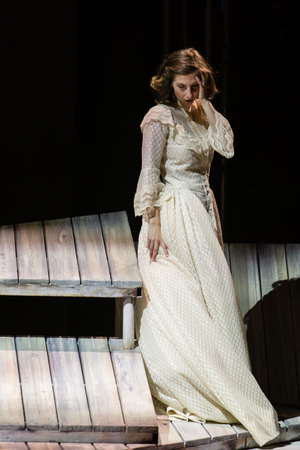Review: BREAKING THE WAVES at Home Computer Screens

On May 29, 2020, Opera Philadelphia presented the digital premiere of Royce Vavrek and Missy Mazzoli's Breaking the Waves, a story based on the 1996 international film of the same name directed by Lars von Trier. Winner of the Music Critics Association of North America 2017 award for Best New Opera, the story took place in the 1970s at a seaside settlement in the Scottish Highlands. It opened with the courtship and wedding of local villager Bess McNeill sung by the energetic soprano Kiera Duffy and an outsider, oil rig worker Jan Nyman, sung by handsome baritone John Moore.
Breaking the Waves was a tour-de-force for Duffy who remained on stage almost all the time. Illustrating every facet of her character's complicated and not-always-stable psyche, Duffy held watchers firmly in her hand while she convinced them of her character's sincerity. She showed Bess's awakening to the delights of passionate love in her exuberant rendition of "His name is Jan." She revealed the depth of her love when she did his bidding even though the thought of infidelity cried out against her moral upbringing.
James Darrah's stage direction, Adam Rigg's set design, and Adam Larsen's projections evoked the barrenness of both the Scottish setting and the stark religion held to be of maximum importance by the villagers. Although the production was monumentally simple, it told the opera's complicated story effectively. Large planks assembled in different configurations represented each setting and, as characters made use of them, their relationships to the story became apparent.
At Bess's wedding, for example, the absence of decoration other than rough boards and planks suggested the Church's unyielding, iron-clad laws. Later on, the music achieved a mystical quality that was less well represented in the staging. Bess had asked about bells at her wedding because there were none. At the opera's end there were bells that reminded the audience of Bess's longing for them.
Costume designer Chrisi Karvonides placed the opera firmly in the 1970s with flattering short skirts and sensible low heeled shoes for women and work-soiled oil rigger clothes for the leading men. Bess wore a long white cotton wedding gown with simple ruffles. Members of the all-male chorus sported heavy coats of what looked like good Scottish wool.
The absence of a women's chorus illustrated the position of women in the village and the church at that time. The Church Elder told Bess that women were not heard there. He admonished her as a wife to obey her husband, so when Jan told her to have sex with other men and to tell him all the details, she did exactly that. The Elder then refused to let her continue as a church member.
As Jan, baritone John Moore offered a gleaming, bronze-tinged vital sound that defied the fact he was confined to a rustic plank bed for most of the show. Sweet-voiced Eve Gigliotti sang with a great deal of poignant expression as Bess's sister-in-law, Dodo McNeill. She also proved to be a sympathetic actress. As the Mother, Patricia Schuman conveyed the image of a staunch church member and made little attempt to understand Bess's predicament. David Portillo portrayed a lyrical Dr. Richardson who tried his best to help both Bess and Jan. Zachary James was a robust Terry and Marcus DeLoach an inflexible Minister.
Breaking the Waves was an unusual tale told with great clarity. It presented the audience with a tapestry full of emotional and musical colors. Vavrek's libretto lept from one emotional peak to the next with precision and security. This opera was both powerful and challenging because of its raw sexual content. Missy Mazzoli met its challenge musically with characters that told their stories boldly as their vocal lines harmonized inventively with the snatches of melody that inhabited this composer's sometimes dense accompaniment. She divided her musical lines between telling the story and allowing the characters to express their feelings about their situations.
Most importantly, Mazzoli knows how to write for the voice. She fashioned each of her characters with individual vocal and textural contours so that her singers never seemed to tire. Conductor Steven Osgood kept all the disparate parts of this most interesting opera functioning like the wheels of a well oiled machine, at the same time allowing the singers to breathe comfortably. Readers can see Breaking the Waves on Opera Philadelphia's website through Monday, August 31, 2020. https://www.operaphila.org/whats-on/digital-festival/ It's sung in English and has English titles as well.
Photo: Domenic M. Mercier for Opera Philadelphia
Reader Reviews

Videos

